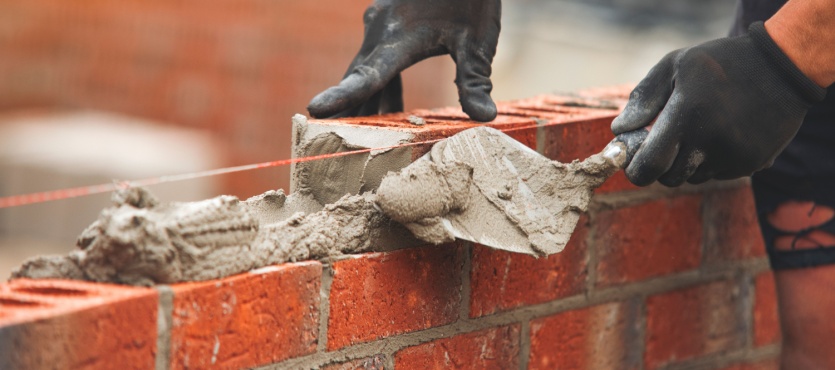Masonry structures, made of brick, stone, and mortar, are renowned for their durability and timeless beauty. However, despite their strength, these materials are not immune to the damaging effects of water. Over time, moisture can infiltrate masonry, leading to cracks, deterioration, and costly structural damage. Understanding how water affects brick and stone and learning how to protect your masonry from moisture can save homeowners from extensive repairs and preserve the integrity of their property.
How Water Affects Masonry
Brick, stone, and mortar are naturally porous materials, which means they can absorb moisture. When water infiltrates masonry, several damaging processes can occur, especially if left unchecked.
Freeze-Thaw Damage
In cold climates, the freeze-thaw cycle is one of the most significant threats to masonry. Water enters the pores and small cracks in bricks and stones, and when temperatures drop, this water freezes. As water freezes, it expands, placing stress on the masonry. Repeated freeze-thaw cycles cause bricks and mortar to crack, spall (flake off), and deteriorate over time.
Efflorescence
Efflorescence is the white, powdery residue that can appear on brick or stone surfaces. This occurs when water carries soluble salts from within the masonry to the surface, where it evaporates, leaving the salts behind. While efflorescence itself isn’t structurally damaging, it is a sign that water is infiltrating the masonry. If left untreated, this moisture can lead to more serious problems, including cracking and decay.
Mold and Mildew Growth
Moisture trapped in masonry can create an ideal environment for mold and mildew growth. This not only affects the appearance of your brick or stonework but can also pose health risks, particularly if the moisture seeps into the interior of your home. Mold growth is often a sign of prolonged water infiltration, indicating the need for immediate attention.
Deterioration of Mortar Joints
Mortar, which holds bricks or stones together, is especially vulnerable to water damage. Over time, mortar joints can erode or crack due to moisture exposure, leading to gaps between the bricks or stones. These gaps can allow more water to penetrate the structure, further accelerating deterioration and potentially leading to structural instability.
How to Prevent Moisture Damage in Masonry
Fortunately, there are several strategies homeowners can implement to protect their masonry from water damage. Preventing moisture infiltration is key to maintaining the structural integrity and appearance of brick and stone surfaces.
Ensure Proper Drainage
Water pooling around the base of your home is a primary cause of moisture damage in masonry. Ensuring proper drainage is essential for protecting brick and stone structures. Gutters and downspouts should be clean and functioning properly to direct water away from the foundation. The ground around your home should be graded so that it slopes away from the foundation, preventing water from accumulating near the base of masonry walls.
Seal Your Masonry
Applying a high-quality, breathable masonry sealant can be an effective way to protect your brick or stone from water damage. Sealants act as a barrier, preventing water from being absorbed into the masonry while still allowing trapped moisture to escape. It’s important to choose a breathable sealant, as non-breathable products can trap moisture inside the bricks or stones, causing further damage. Depending on your climate and the condition of your masonry, sealants should be reapplied every 5 to 10 years to ensure continuous protection.
Repair Cracks and Damaged Mortar
Even small cracks in bricks or mortar can allow water to enter and cause further damage. Regular inspections of your masonry for signs of wear and tear are crucial in catching these issues early. Tuckpointing, the process of removing old, deteriorated mortar and replacing it with fresh mortar, not only improves the appearance of brickwork but also restores its structural integrity by keeping water out. For larger cracks, professionals may use specialized fillers or inject epoxy to prevent water from penetrating the structure.
Install Flashing
Flashing is a thin layer of waterproof material installed at junctions where masonry meets other structures, such as where the roof meets the chimney or where windows meet brick walls. Properly installed flashing helps direct water away from the masonry, preventing it from entering the structure. Flashing can wear out over time, so it’s important to have it inspected regularly. Damaged flashing should be repaired or replaced promptly to ensure it continues to protect your masonry.
Regular Maintenance and Inspections
Routine maintenance is critical in preventing water damage. Homeowners should inspect their masonry structures regularly for signs of damage, including cracks, spalling, or efflorescence. Addressing issues promptly can save you from more extensive and costly repairs later. Chimneys, in particular, are vulnerable to water damage because they are exposed to the elements year-round. Regular chimney inspections and maintenance, including sealing cracks and ensuring the chimney cap is in place, are essential for keeping moisture out.
Safeguarding Your Masonry from Water Damage
Water is the most common enemy of masonry, capable of causing significant damage over time if left unchecked. However, with proper care and preventative measures, you can protect your brick and stone structures from moisture damage, ensuring their beauty and integrity for years to come. By ensuring proper drainage, applying protective sealants, and conducting regular inspections and repairs, you can minimize the effects of water on your masonry and prevent costly repairs.
For professional masonry maintenance and waterproofing solutions, reach out to Turnbull Masonry. Their expert team can help safeguard your brick or stone home from moisture damage and keep it looking beautiful for years to come.

